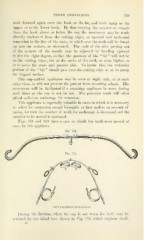Page 771 - My FlipBook
P. 771
UPPER PROTRUSION. '69
cord forward again over the hook on the bit, and back again to the
upper or to the lower hook. By thus varying the number of strands
from the hook above or below the ear, the movement may be made
directly backward from the cutting edges, or upward and backward
somewhat in the line of the roots, in which case the teeth will be forced
up into the sockets, or shortened. The ends of the wire passing out
of the corners of the mouth may be adjusted by bending upward
to just the right degree, so that the pressure of the "bit" will not be
on the cutting edges, but at the necks of the teeth, or even higher, so
as to move the roots and process also. To insure this, the vulcanite
portion of the "bit" should pass over the cutting edge so as to grasp
the lingual surface.
This cap-and-bit appliance may be worn at night only, or at such
other times as will not prevent the patient from attending school. The
movement will be facilitated if a retaining appliance be worn during
such times as the cap is not in use. The posterior teeth will often
aiford sufficient anchorage for retention.
This appliance is especially valuable in cases in which it is necessary
to select for extraction second bicuspids or first molars on account of
caries, for then the number of teeth for anchorage is decreased and the
number to be moved is increased.
Figs. 768 and 769 show a case in which ten teeth were moved at
once, by this appliance.
Fig. 770.
Angle's appliance for retraction.
During the daytime, when the cap is not worn, the teeth may be
retained by the labial bow shown in Fig. 759, which explains itself.
49


